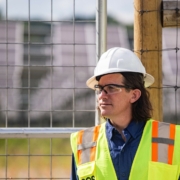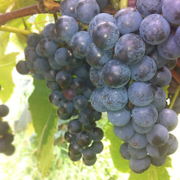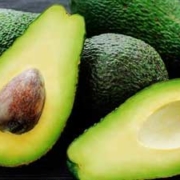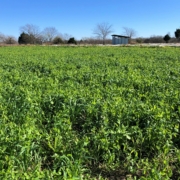Maces Pond: Agrisolar Wild Blueberries
 Print This Post
Print This Post
By Chris Lent, NCAT Agriculture Specialist
Not far from the town of Rockport, Maine, Paul Sweetland of Sweetland Farms, LLC has been tending wild blueberries since he was a young boy. On one field that he has been farming since the late 1990s, there is more than blueberries being produced. Solar panels have been installed over about 11 acres of wild blueberry plants in the first project in Maine to collocate solar electric production with wild blueberry cultivation. The project was developed by BlueWave, a Boston-based solar development company, and installed by CS Energy in the spring and summer of 2021.
When the owner of this land, David Dicky, started receiving solicitations from solar companies to lease his land for solar development, he was interested. However, he didn’t want to see acres of wild blueberries destroyed in the process of constructing a solar array. After consulting with several solar developers, he began working with BlueWave because of their experience and openness to developing dual land use solar installations. Dual-use solar, also called agrisolar or agrivoltaics, pairs agricultural production and solar electric production on the same land. BlueWave, with input from Mr. Sweetland and Dr. Lily Calderwood, a horticulturalist at the University of Maine, developed a solar site plan that would protect the berry plants and research the impacts of the solar installation on wild blueberry production. After a nearly two-year permitting process, Bluewave and CS Energy began installation in early 2021, aiming to have the project finished by late spring to allow time over the summer for the blueberry plants to recover.
Navisun, a Boston-based solar independent power producer, purchased the solar project from Bluewave in early 2021. They worked closely with the installer, the landowner, and Sweetland Farms to ensure that this agrisolar project was financially viable for everyone. Both Navisun and Bluewave have made a commitment to innovation and land stewardship in solar development and have actively pursued agrisolar projects like this one to fulfill that commitment.
Bluewave funded research by Dr. Calderwood to study the effects of solar construction on the established blueberry plants. To do this, the construction area was divided into three sections. In one section, panels were installed using standard practices and equipment. In the second section, the crew was mindful of reducing passes with heavy equipment, sharp turns, and other practices that can rip and damage the ground and plants. In the third section, they used polyethylene ground-protection mats and were very careful about using the same access paths and minimizing equipment passes through planning and efficiencies. The construction crew went through training on these low impact techniques before construction began.
Commercially managed low bush or wild blueberries are harvested in July and August and then the farmer either burns off or mows the plants in the fall. The following year, the plants are in a vegetative cycle building new growth. It isn’t until the following year that the plants enter a cropping cycle, the berries are harvested, and the cycles start over again. Construction on this project took longer than planned, leaving a shorter time for the plants to recover in the first year. Despite this, the blueberries in all three sections rebounded, with the section containing the most protected plants rebounding more quickly and with better vegetative growth in the first year. The plants produced almost no berries in the harvest year of 2022. Dr. Calderwood attributes this to the short time the plants had to recover in the year of construction and the shade from the solar panels. More will be known about how well the berries will produce under the panels as the study continues through the 2024 harvest .
The solar array covers nearly 11 acres of land plus an access road and is sized to produce 4.7 megawatts of DC power. To date, power production from the system is higher than was estimated. The system consists of a combination of one-sided (monofacial) and two-sided (bifacial) panels on a fixed-tilt racking system. The height and row spacing of the panels follow conventional solar development design, with the upper height at about 8 feet and the space between the rows of panels also about 8 feet. To accommodate for deep snow in the winter, the height of the drip edge, which is the distance from the front edge of the lower panels to the ground, was increased from a typical 30 inches to 5 feet. This additional height slightly increased the cost of the system but is standard procedure for Navisun on projects located in high snow areas and had the benefit of creating some extra height for working the blueberry crop under the panels. Navisun indicated that the installation costs were slightly above market cost for this size system.
Through Maine’s Net Energy Billing Program, the local power company allows Navison to create energy credits based on the solar energy generated at the site. Navison then offers and sells those credits to small commercial customers in the area. Navisun pays the landowner a lease payment for the acreage the solar array occupies and subleases the land under the panels to Mr. Sweetland, agreeing to pay him a stipend as the caretaker of those grounds for at least the first five years the system is operating. This stipend can help offset any losses to Sweetland Farms if there is a reduction in blueberry production under the panels and isn’t an extra expense for Navisun, as they would need to arrange and pay for grounds maintenance in any solar development. Sweetland Farms also has an agreement to pay the landowner a percentage of the gross income from the cultivation and harvest of wild blueberries on the site. This creative arrangement of leases, subleases, and payments is a way to ensure everyone involved is treated fairly and is happy with the financial aspects of the project.
One challenge in dual-use agrisolar projects like Maces Pond is finding the balance between energy production of the panels and crop production under the panels. The partners involved in developing this project knew that energy production would be a focus but also wanted to protect and track the production of wild blueberries under the panels. The data collected from this research and lessons learned could inform future projects and open the door for other wild blueberry landowners in Maine to diversify their income from their property.
Because the panel height and width between the rows of the array were not designed to allow for traditional farming equipment adjustments have been made to help work the blueberries under the panels. For example, an ATV is now used for any spray applications and a walk behind harvester will be used under the panels instead of tractor-pulled harvest equipment. Mr. Sweetland and others working under the panels learned to always wear a hard hat to avoid the risk of hitting their heads on the solar racking.
Trialing different levels of care for the protection of the ground and berry plants during installation has shown that with the right methods the natural state of a site can be protected during the construction phase. With some planning and simple techniques, damage to a site’s ecology can be minimized. 75% of the wild blueberry plant is below ground in the root system so the tops can be damaged without killing the plant. All the berry plants rebounded after the construction phase, but those that were protected the most did the best.
There is some concern among communities in Maine that solar development will destroy wild blueberry fields which can take 10 or more years to establish. When the landowner in this project decided to move forward with a solar development project on his land, he visited his neighbors to talk to them and they all have been supportive of the project. Mr. Sweetland believes that support was bolstered by proactively approaching the neighbors and by the agrisolar nature of the project, which allowed for the preservation and continued production of blueberries under and around the solar panels.
Dr. Calderwood will continue to collect data on shade levels, soil temperatures, plant density, insect and weed pressures, blueberry bud and fruit counts, crop yield, berry size, and more through 2024. That research is funded through a Northeast SARE Novel Approach grant and more information on Dr. Calderwood’s research on this project can be found at the University of Maine Cooperative Extension: Wild Blueberry page.
Related NCAT Resources:
Blueberries: Organic Production
Tree Fruits: Organic Production Overview

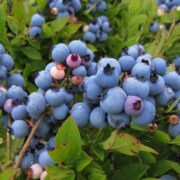 Wikimedia
Wikimedia